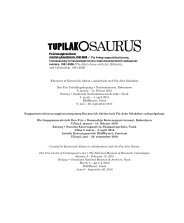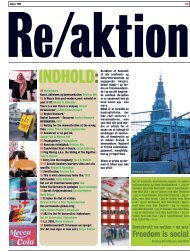tupilakosaurus - Print matters!
tupilakosaurus - Print matters!
tupilakosaurus - Print matters!
You also want an ePaper? Increase the reach of your titles
YUMPU automatically turns print PDFs into web optimized ePapers that Google loves.
ISSITTUMI SILAARUT-<br />
TUTUT KAMANNEQ<br />
issitsinikkut, suiaassuseq apeqqutaanngilaq.<br />
Suiaassuseq pinngortitaanerlu Freud<br />
isumaliutaanut tunoqqutsilluni takkuttarpoq.<br />
Kinguaassiutitigut piumassuseq immikkoortunut<br />
marlunnut immikkoortikkamiuk,<br />
immikkut illuatungeriissillugik nassuiaatigineqarsinnaasunut:<br />
Angutip iliuuseqarnikkut<br />
arnallu uninngasumik kinguaassiutitigut<br />
piumassuseqarnerinut.<br />
Puuttarnerup nassuiarneqarnermigut<br />
silarsuaq iliuuseqanngitsutut misigisarmagu,<br />
ilimagisap qanganitsap atuutileqqinnissaa<br />
ungasinngilaq, puunneq – issittuni allaniluunniit<br />
kiannerusuni atuuttartoq – tassa arnani<br />
atuunnerusartoq.<br />
Saqqummersitap immikkoortuani uani<br />
neriuutigaarput takutissallugu, nunasiaateqarnerup<br />
isumaliortaatsikkut naqisimannittaasia<br />
ammip qalipaataannaannik<br />
atortoqanngimmat, kisialli aamma kinguaassiutikkut<br />
isiginnittaatsikkut immikkut<br />
ittukkut, tassa inuianni ingasattajaartumik<br />
arnaassuseqarneranik isiginnittaaseq.<br />
Allatut oqaatigalugu nunasiaateqarniat<br />
tamatigut nunat inoqqaavisa inooriaasii<br />
arnarpalunnermik takutitsisutut isiginiartarsimavaat,<br />
taamalu isiginnittaatsip nassataralugu<br />
nammineq aallaavitsik anguterpaluttuusoq.<br />
Taama isiginnittaaseqarnerup<br />
nassataraa kulturini taakkunani allatut<br />
isumaasinnaasut sakkukillisarneqartarneri<br />
iml. eqqaanaveersaarneqartarneri.<br />
Taama isiginnittaatsimi nunat inoqqaavini<br />
angutit angutaassuseqanngillat. Arnarpasillutilli<br />
iliuuseqassanatik. Arnartaalli tamani<br />
suli iliuuseqannginnerusarlutik.<br />
Taamaalilluni ammip qalipaataa suiaassuserlu<br />
naapertorlugit naqisimannittarneq<br />
isumaliortarnermut sanileriillutik tunngaviuinnaratik,<br />
aammali naqisimannittarnermi<br />
assingusuullutik sakkuupput, atorneqartarnermikkut<br />
imminnut piorsaqatigiittartut.<br />
Ileqqut taakku arlaannaalluunniit salliutinngikkaluarlugu<br />
Arkep misissorniarsimavai,<br />
pissaaneq naligiinnginnerlu suiaassutsip,<br />
kinguaassiutitigut piumassuseqarnerup, utoqqaassutsip,<br />
inuiaqatigiinni inissisimanerup,<br />
iliuuseqarsinaanerup (timikkut tarnikkullu)<br />
kiisalu inuiaassutsip kinaassuserneqartarneranut<br />
qanoq atorneqartarneri misissorsimallugu.<br />
Arkemut ilisarnaataasumik misissuineq<br />
tamanna kinaassutsinut inuiaqatigiillu inuit<br />
arnartaasa timaannut isiginnittaatsit akornanni<br />
naapiffiit alianartuugatillu, persuarsiornaratillu<br />
killisimaarnanngillat. Paasinninnermilli<br />
qaninneraluni tissinarluni ilaatigullu<br />
quianarsinnaalluni.<br />
Isikkummi suussuseq takutittanngilaa.<br />
Issittumi silaaruttutut kamanneq issittuni<br />
ilisimasassarsiortut amernik ingasaallugu<br />
oqorsaasersorsimasut tunuani toqqukkanik<br />
ima angitigisumik kusanartigisoqarpoq,<br />
soorlu sanianiittut issittumi isiginnaagassiat-takutitsisut<br />
pinngortinneqarnerminni<br />
nunasiaanerullu pitsaanerpaannik tunniussaannik<br />
kusanassuseq takutikkaat.<br />
THEME SECTION 3: ARCTIC HYSTERIA<br />
This section takes its immediate point<br />
of departure in a work from 1997<br />
titled Arctic Hysteria (sometimes also<br />
referred to as Arctic Hysteria IV). It<br />
was the perhaps most exotic of the<br />
many fruits born of Pia Arke’s investigations<br />
of the phenomenon – and<br />
in a further sense of the interaction<br />
between gender and colonisation.<br />
It may seem surprising but this<br />
aspect of her work is strikingly absent<br />
from the analyses, critiques and curatorial<br />
concepts that her oeuvre has<br />
so far occasioned. Nonetheless there<br />
are myriads of women in Arke’s pictorial<br />
universe – dressed, undressed,<br />
stripped, old, young, dumbstruck,<br />
in love. You name it. And it teems<br />
with virtues that have traditionally<br />
masculine connotations – like polar<br />
exploration, mapmaking, hunting and<br />
photography.<br />
Perhaps this is related to the fact<br />
that ethnicity, “race” and originality<br />
are stronger markers of “otherness”<br />
than gender? Or, rather, that it is<br />
asking too much of Western thinking<br />
to expect it to think both categories<br />
together and not just focus either on<br />
gender or on ethnicity.<br />
What ever the explanation, “Arctic<br />
hysteria” is a concept in psychopathology;<br />
a Western scientific tradition<br />
that concerns itself with how psychic<br />
disorders arise, and how they are<br />
expressed in the form of symptoms<br />
and personal characteristics.<br />
More precisely, it is a designation<br />
for a so-called culturally conditioned<br />
state that is thought to manifest itself<br />
especially in winter and mostly in<br />
Inuit women living north of the Polar<br />
Circle. The symptoms are terrifying<br />
in themselves: hysteria, depression,<br />
eating faeces, insensitivity to severe<br />
cold and the senseless repetition of<br />
overheard words.<br />
For many years it had been thought<br />
that hysteria was a psychic state<br />
that was due to a uterine disorder<br />
The father of the art of medicine,<br />
Hippocrates, explained that hysteria<br />
was caused by the womb that in its<br />
longing to be impregnated begins to<br />
wander around in the body.<br />
Freud later demonstrated the<br />
falsity of this assumption and succeeded<br />
in placing the womb in the<br />
position it occupies today. Instead he<br />
determined that hysteria was due to<br />
the inadequate repression of sexual<br />
violations or merely conflicts between<br />
sexual wishes and inner prohibitions<br />
in childhood. In this explanatory<br />
model the violation and the conflict<br />
reappear in the adult in the form of<br />
hysterical symptoms. This is in fact a<br />
causal explanation that has nothing<br />
to do with gender really.<br />
But in Freud gender and biology<br />
nevertheless sneak in through the<br />
backdoor. For the domain of sexuality<br />
is divided here into two exhaustive<br />
and mutually exclusive categories:<br />
active male and passive female sexuality.<br />
As the hysteric, by definition,<br />
experiences the world passively, it is<br />
not far to the reinstatement of the antique<br />
thesis that hysteria – whether<br />
it is Arctic or of a more temperate<br />
nature – is a typically female phenomenon.<br />
With this section we hope to negotiate<br />
the idea that colonialism’s most<br />
important form of repression is not<br />
only racism, but also the special form<br />
of sexism contained in the hyper-feminisation<br />
of the ethnic woman.<br />
In other words, colonialists have<br />
consistently read the cultures of indigenous<br />
peoples as signs of femininity,<br />
while the culture of the metropole<br />
was of course read as masculine. The<br />
elements in both cultures that conflicted<br />
with this system have accordingly<br />
been downplayed or repressed.<br />
In this optic the men of the original<br />
peoples were not proper men. On the<br />
contrary, they were feminine and passive.<br />
However, the most passive of all<br />
were the indigenous women.<br />
Racism and sexism are therefore<br />
not just ideologies, living next door to<br />
one another, but also related forms<br />
of oppression, that help to create and<br />
maintain one another.<br />
Without declaring adherence to<br />
any particular critical tradition Arke<br />
nevertheless investigated how power<br />
and inequality seem to be constant<br />
ingredients in the recipe for such<br />
categories of identity as gender, sexuality,<br />
age, class, functionality (of body<br />
and mind) and ethnicity.<br />
It was characteristic of Arke that<br />
the investigation of the intersection<br />
for all these identities and ideologies<br />
in the body of the Inuit woman becomes<br />
neither tragic, nor pathetic, nor<br />
sentimental. Rather, it is empathic,<br />
humorous and at times ironic.<br />
For appearances can be deceptive,<br />
as we know. And behind the exaggeratedly<br />
fur-clad polar explorers in<br />
Arctic Hysteria there is concealed just<br />
as much naked beauty as the Arctic<br />
nudes standing at their side had been<br />
so copiously endowed with by nature’s<br />
and colonialism’s hand.<br />
23




